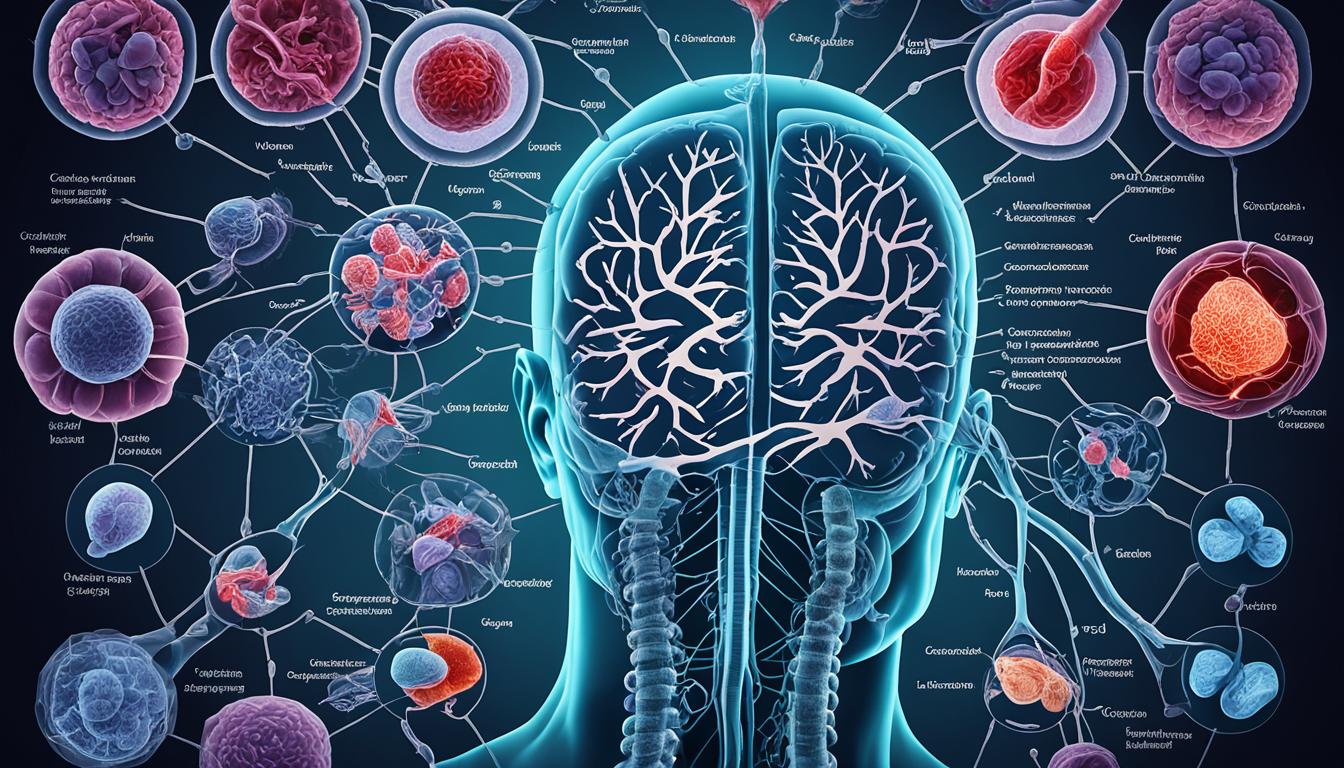MEN 2 is a genetic disorder leading to tumors in the endocrine system. These tumors can form in the thyroid, adrenal glands, and parathyroid. It’s caused by changes in the RET proto-oncogene, a gene controlling cell growth and division.
There are two main types of MEN 2: MEN2A and MEN2B, with different symptoms. MEN2A leads to issues like medullary thyroid carcinoma (MTC) and hyperparathyroidism. MEN2B includes many of the same problems but also adds mucosal neuromas and marfanoid habitus.
Diagnosing MEN 2 requires genetic testing to spot mutations in the RET gene. Early diagnosis is vital for good treatment. Treatments might include surgery to remove affected glands and the use of stem cell therapy.
Key Takeaways:
- MEN 2 comes from genetic problems and causes tumors in the endocrine system.
- It has two common types, MEN2A and MEN2B, with their unique symptoms.
- Genetic testing is very important to find MEN 2 by checking for mutations in the RET gene.
- Discovering MEN 2 early is crucial for better treatment.
- Surgery and stem cell therapy can help treat MEN 2.
Symptoms of MEN 2
MEN 2, known as multiple endocrine neoplasia type 2, is a genetic disease that affects the endocrine system. It leads to tumor growth. The symptoms of MEN 2 vary with each subtype.
Common symptoms of MEN 2 include:
- Thyroid nodules or masses
- Elevated calcium levels
- Excessive sweating
- High blood pressure
- Abdominal pain
- Constipation
- Skeletal abnormalities
MEN2B has extra symptoms like mucosal neuromas, marfanoid habitus, and ganglioneuromatosis.
The symptoms’ seriousness and how they combine change for each person with MEN 2. Some people might not show symptoms early in the disease.
Different Subtypes of MEN 2
MEN 2 has subtypes like MEN2A and MEN2B. Each subtype has its own set of symptoms. For example, MEN2A often has medullary thyroid carcinoma (MTC), pheochromocytomas, and hyperparathyroidism. MEN2B is known for MTC and pheochromocytomas, and it includes mucosal neuromas, marfanoid habitus, and ganglioneuromatosis.
Knowing early about MEN 2 is key for better care and treatment. If you have some symptoms or a family history of MEN 2, talk to a doctor for checkup and tests.
Causes and Diagnosis of MEN 2
MEN 2, or multiple endocrine neoplasia type 2, is a genetic disorder. It comes from changes in the RET proto-oncogene. This gene controls how cells grow and divide. People get MEN 2 if they inherit a changed gene from their parents.
To find out if someone has MEN 2, doctors use genetic testing. This test checks for certain changes in the RET gene. It shows for sure if MEN 2 is present. Doctors might do this test before or after a baby is born to see if they got the changed gene. People with family history or symptoms should consider this test.
Besides genetic testing, doctors also look at family history and do physical exams. They might also order ultrasounds, CT scans, or MRI scans. These tests help figure out the disease’s stage. They also look for any tumors or problems in the body’s hormone glands.
Diagnosing MEN 2 early is key. It helps with managing and treating the disease. When the gene problem is found early, possible treatments can start. This includes removing affected glands and starting special therapies.
Knowing how MEN 2 comes about is important. It helps give the right care quickly. Thanks to genetic tests and other checks, doctors can spot MEN 2 early. Then, they can plan treatment that fits each person’s situation.
Treatment of MEN 2 and Advancements in Stem Cell Therapy
The treatment for MEN 2 focuses on easing symptoms and lessening tumor size. A team of healthcare experts works together to make a custom treatment plan. This can involve surgeries to take out affected glands like the thyroid and adrenal glands. Removing these glands can help stop symptoms and reduce tumor risks.
Sometimes, treatments like radiation and chemo are needed, depending on how bad the disease is. These fight the tumors to stop them from growing. But, they can also have bad side effects, so they’re used carefully.
Stem cell therapy is a new area showing promise for MEN 2 care. Stem cells can change into different cell types in the body. This makes them really exciting for fixing damaged tissues. While still in its early days, stem cell therapy offers hope for possibly fixing MEN 2 effects for the long term. Yet, we need more studies to know how well it works and its safety for MEN 2 patients.

